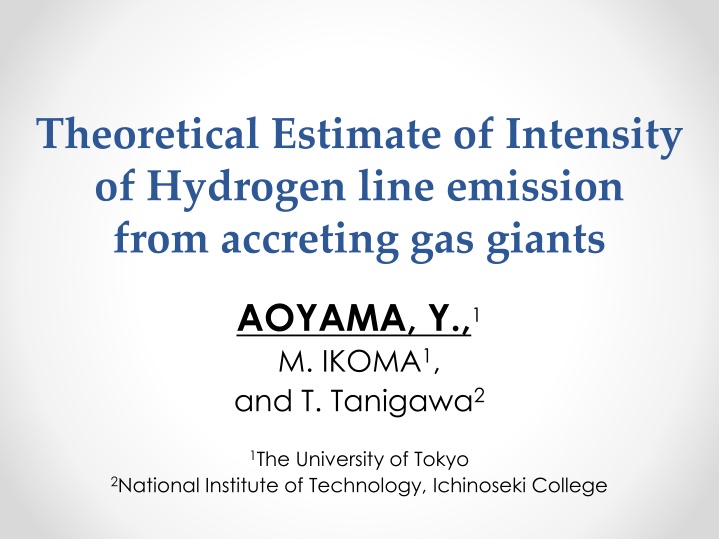
Estimation of Hydrogen Line Emission Intensity from Accreting Gas Giants
Explore the theoretical estimation of hydrogen line emission intensity from accreting gas giants, delving into observational points, black-body temperature, line emissions, shocks, and the purpose of the study. The model considers continuous flow cooling, vertically accreting shock heating, and various chemical species. Dive into the processes involved in understanding the yield of H-line around accreting gas giants.
Download Presentation

Please find below an Image/Link to download the presentation.
The content on the website is provided AS IS for your information and personal use only. It may not be sold, licensed, or shared on other websites without obtaining consent from the author. If you encounter any issues during the download, it is possible that the publisher has removed the file from their server.
You are allowed to download the files provided on this website for personal or commercial use, subject to the condition that they are used lawfully. All files are the property of their respective owners.
The content on the website is provided AS IS for your information and personal use only. It may not be sold, licensed, or shared on other websites without obtaining consent from the author.
E N D
Presentation Transcript
Theoretical Estimate of Intensity of Hydrogen line emission from accreting gas giants AOYAMA, Y.,1 M. IKOMA1, and T. Tanigawa2 1The University of Tokyo 2National Institute of Technology, Ichinoseki College
1-1. Accreting Gas Giants Observation Observational Points and Theoretical lines Image of Accreting Giant 10 Estimated emission from accreting disk L Ks H Where it comes from? IR band Flux (mJy) Central Star LkCa15A Estimated emission from accreting planet 2015.11 sallum+ 0.1 1 10 Wave length ( m) IR emission H line can be explained is never explained
1-2. Black-body temperature Heating process viscous heating shock heating release of gravitational energy Cooling by the black body radiation
1-3. Line emission H (observed in LkCa15b) quantum number n=4 n=3 Principal n=2 Ly n=1 ground state Collision free electron Line emission needs much high temperature (>104K) IR emission means lower temperature (<103K)
1-4. Shock with Vertical Inflow Tanigawa+2012 edge on verticallyaccretingflow CPD CPD Shock Planet Gas temperature reaches >104K near the planet. When this hot gas cools rapidly, hardly affects IR continuum.
1-5. Purpose of this Study To understand how H line is yielded around accreting gas giant. To estimate intensity of H lineemitted from vertically accreting gas flow. To constrain the gas giant forming condition by usingobserved H line.
2. Model continuous flow cooling vertically accreting shock heating (including Line cooling) initial parameters v0: gas velocity n0: gas number density numerically calculate the flow after the shock Considered processes assuming 1D flow Hydrodynamics 33 chemical species composed with H, He, C, O Chemical Reaction 10 electron levels and ion state of hydrogen Electron Transition emission and absorption of 55 lines and continuum of H Radiative Transfer
v0=40km/s n0=1017m-3 3-1. Temperature shock surface t=0 10-7 10-6 depth from shock surface 10-5 time(s) 10-4 10-3 ~10-3s 10-2 10-1 ~1s 1 103 105 104 Temperature (K)
v0=40km/s n0=1017m-3 3-2. Chemical species zz 10-7 State of Hydrogen H2O H H2 OH 10-6 10-5 H2 time (s) 10-4 ~10-3s 10-3 CO H (~100%) 10-2 H+e- 10-1 ~10-2s H+ (~10%) 1 1 5 10 10-4 10-6 10-2 ratio to H Temperature (104K)
v0=40km/s n0=1017m-3 3-3.Line Enery Flux 10-7 10-6 Paschen Lyman H 10-5 time (s) radiation 10-4 upward 10-3 10-2 10-1 100 101 5 10 2 10-4 10-1 102 105 Energy flux (W/m2) Temperature (104K)
3-4.H Intensity with v0 Free fall 5 1020 m-3 1019 m-3 3 log(Energy flux) CPD 1018 m-3 1 (W/m2) r v0 1017 m-3 -1 1016 m-3 -3 1015 m-3 -5 50 80 30 10 v0 (km/s)
3-5. H Luminosity 20 19 log(n0)(m-3) 18 17 16 15 1Planet mass (Mj) 10
4-1. LkCa15b 20 1023W 19 LkCa15b 2.2 1022 W log(n0)(m-3) LkCa15b 18 MMSN (12.6AU) 17 16 1017W 15 1Planet mass (Mj) 10
Summary Background Recently, some forming gas giants have been observed. How H line is yielded is yet understood. Purpouse To explain the H line intensity of LkCa15b To constrain the condition of gas accretion Method We numerically calculate radiative cooling with 1D flow, chemical reaction, electron transition, and radiative transfer. Result H line intensity from shock heated gas is strong enough to be observed. Conclusion By using our model, H line intensity constrains the planet mass and gas number density.

